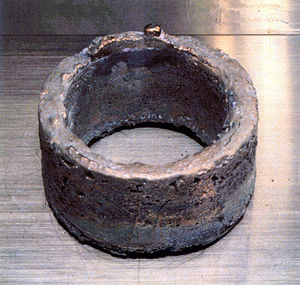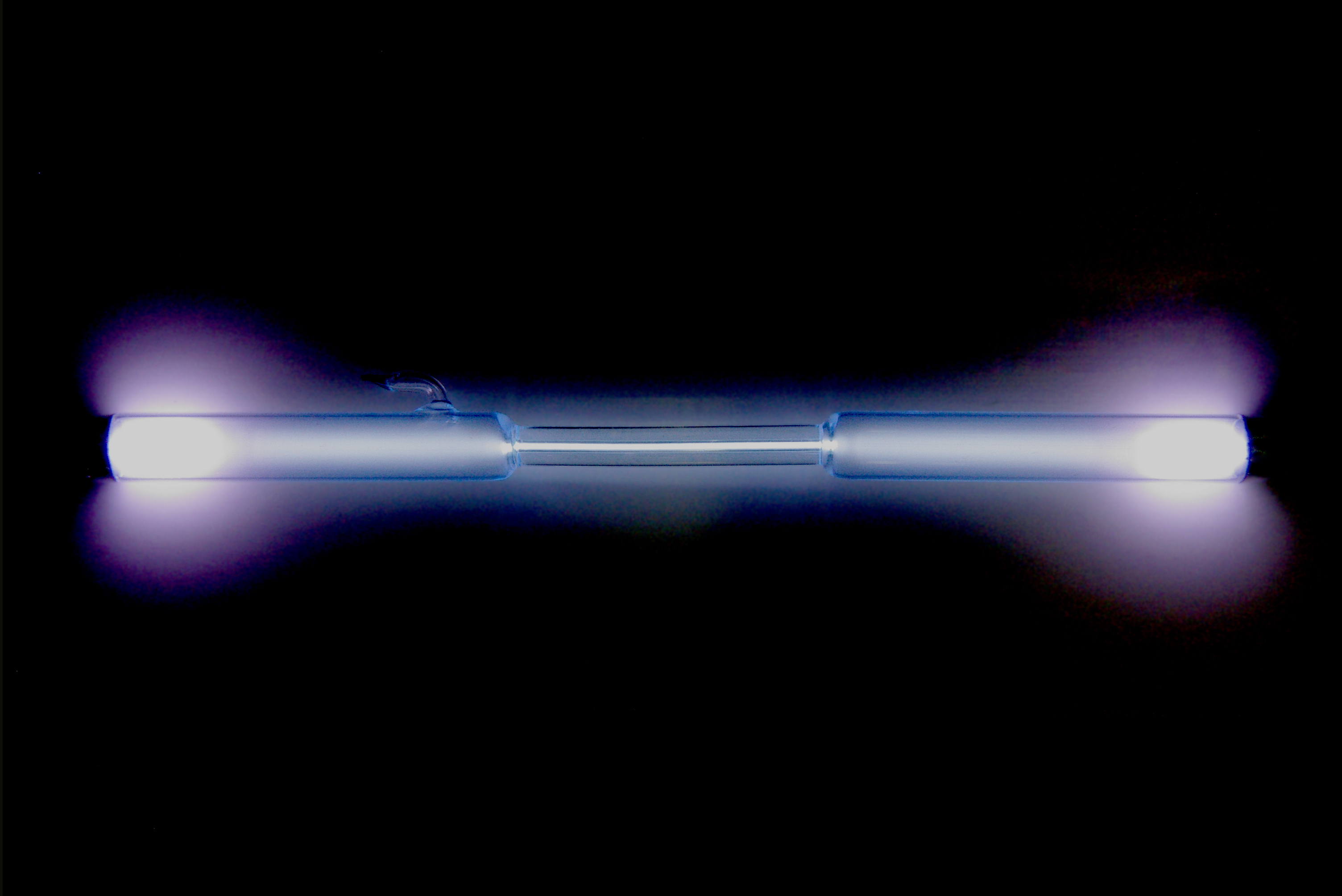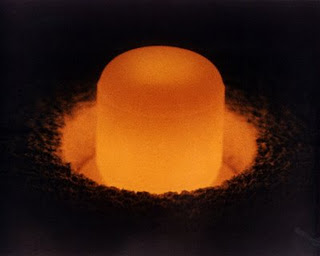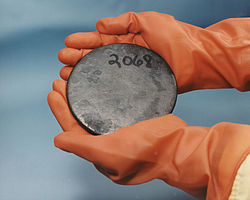Plutonium-239
Plutonium-239 is a plutonium isotope used to manufacture nuclear weapons. Plutonium-239, along with uranium-233 and uranium-235, is one of the three principal isotopes used as a fuel in nuclear reactors.
Plutonium-239 Nucleus
There are 145 Neutrons and 94 Protons in the Plutonium-239 isotope.
Plutonium-239 Symbol
The symbol denoting Plutonium-239 is written as 239Pu.
Production of Plutonium-239
Plutonium-239 was originally formed at the beginning of the universe. However, having a half-life of only around 24,200 years, naturally occurring traces of Plutonium-239 is hard to find. Trace quantities of this metal are still formed these days when terrestrial Uranium-238 reacts with sun rays. However, this metal nowadays is mostly synthesized artificially. Plutonium-239 is produced from Uranium-238 in nuclear reactors. This reaction is described below:
- Firstly, Uranium-238 is struck with a high-energy neutron and is converted into Uranium-239 with the absorption of a neutron.
- Uranium-239 is then changed into Neptunium-239 by the emission of an electron and an anti-neutrino particle through beta (β–) decay.
- In the final stage, Neptunium-239 loses an electron and an anti-neutrino particle to form Plutonium-239.
Picture 1 – Plutonium-239
Source – en.wikipedia.org
Plutonium-239 Properties
The properties of Plutonium-239 are described below:
Appearance
Plutonium-239 is solid metal with a bright silvery color.
Critical Mass
The critical mass of this metal for a uniform sphere is 11 kg.
Critical Diameter
The critical diameter of Plutonium-239 for a uniform sphere is 10.2 cm.
Isotope Mass
The Isotope mass of this metal is 239.0521634 u.
Decay Mode
Plutonium-239 decays through spontaneous fission while emitting alpha particles.
Decay Energy
While undergoing decomposition, Plutonium-239 releases energy close to 5.245 MeV.
Branching Ratio
Some radioactive materials can undergo decomposition by more than one method. The ratio between the different kinds of particles produced from such decomposition is called the branching ratio of the material. The branching ratio for Plutonium-239 is 100%.
Daughter Nuclide
While undergoing decomposition, it produces Uranium-235 as a daughter nuclide.
Magnetic Dipole Moment
Magnetic dipole moment measures the magnetic strength of a current coil or a magnet. In radioactivity, the orbiting electrons of an atom are said to have a magnetic dipole moment. The magnetic dipole moment of Plutonium-239 is 0.203 μN.
Specific Activity
In radioactivity, specific activity is the number of decays per second per amount of substance, where the amount of substance is either the mass or volume of the substance. It is denoted by the symbol SA. The specific activity of Plutonium-239 is 2.2966 GBq/g.
Solubility
The solubility of Plutonium-239 in water depends on the organic ligands present as well as on the redox and pH of the water.
Plutonium-239 Half-Life
In radioactivity, the half-life is defined as the period of time taken by a certain amount of a radioactive element undergoing decomposition to be decreased by half. The half-life for Plutonium-239 is 24,200 years.
Plutonium-239 Radioactive Decay
The atomic nucleus of Plutonium-239 is unstable; it thereby loses energy to reach a stable stage. This process is known as radioactive decay. Plutonium-239 releases energy of around 5.245 MeV through radioactive decay.
Plutonium-239 Decay Equation
The following equation shows the alpha decomposition of Plutonium-239:
94239Pu → 92235U + 24He
Here the helium nucleus 24He has got atomic number 2 and mass number 4. Helium here denotes the alpha particle. Hence this equation can also be written as
94239Pu → 92235U + α
Plutonium-239 Decay Chain
The decay process of Plutonium-239 produces Uranium-235 as the daughter nuclide. Lead-207 is the stable element produced at the end of this Alpha decay chain. The complete decay chain is expressed in the following reaction:
Plutonium-239 → Uranium-235 → Thorium-231 → Protactinium-231 → Actinium-227 → Thorium-227 → Radium-233 → Radon-219 → Polonium-215 → Lead-211 → Bismuth-211 → Thallium-207 → Lead-207
Plutonium-239 Fission Reaction
Plutonium-239 undergoes fission reaction when it is bombarded by fast or slow neutrons. When a slow neutron is absorbed by this isotope, the fissile reaction produces more than two neutrons. A continuous chain reaction is initiated in case one of these resultant neutrons breaks down another plutonium nucleus.
Plutonium-239 Uses
Plutonium-239 with high levels of purity can be produced in large quantities. Due to its properties, it is extensively used in nuclear power reactors and in the production of nuclear weapons. The various uses of Pu-239 are discussed below:
- Plutonium-239 gathered from dismounted nuclear weapons as well as from nuclear reactors is an important source of energy to generate electricity. Almost around 10 million kilowatt-hours of electricity are produced by one kilogram of Pu-239.
- Almost one-third of the energy that is produced in a commercial atomic power plant comes from plutonium fissions. The fission reaction of Plutonium-239 can be held in the same fuel rods where it is produced.
- Small portions of Pu-239 can be added to newly-manufactured nuclear fuel to produce MOX fuel or mixed oxide fuel, which contains a combination of plutonium oxide and uranium oxide.
- Plutonium-239 is an important fissile material used in the manufacturing of nuclear weapons. Implosion systems are built using Pu-239.
Plutonium-239 Contamination and Health Risks
Plutonium-239 is a dangerous carcinogenic substance. Due to many nuclear experiments over the last 50 years, nearly 10,000 kilograms of this substance have been released into the atmosphere. Release from weapons and other accidental releases have caused much local contaminations. Pu-239 is difficult to track and detect once it is released in the atmosphere or has been absorbed in the body.
In animals, it has been found that high exposure to this substance causes respiratory tract diseases, decreased life spans, and even cancer.
Pu-239 Alpha Radiation Effects
The carcinogenic effect of Pu-239 comes from its alpha (α) radiation. Alpha particles are heavier than the beta and gamma particles and travel a short distance within living tissue while repeatedly hitting the tissues and cells nearby.
Inside the body, Plutonium-239 is mostly deposited in soft tissues, e.g., the liver, the bone marrow, on bone surfaces as well as other non-calcified bone areas.
Gamma radiation of Plutonium-239 is weak; hence a high quantity of this substance is required to cause gamma radiation effects.
Pu-239 Effects in Human Body
Accidental ingestion of the material is quite low as are the risks associated with it. The main health danger from this substance comes from inhaling this substance which can cause damage to the tissues of the bronchial tubes and lungs. It can also accidentally be absorbed in the blood stream through abrasions and cuts. Deposits of Pu-239 may ultimately cause cancer in the long run.
The half-life of this substance in the body varies on where it is deposited. In the human liver, it has a half-life of 20 years and in the bones, it is around 50 years.
Of all the isotopes of plutonium, Plutonium-239 is the one most widely used. Although considered to be one of the most carcinogenic of all radioactive substances, it has found widespread use in nuclear reactors and in the generation of electricity.
- References
- http://www.world-nuclear.org/info/inf15.html
- http://areva.com/mediatheque/liblocal/docs/pdf/energies/pdf-savoir-plutonium-va.pdf






How is plutonium-239 produced for nuclear bombs. I interviewed at Lawrence Livermore & learned LL used Copper Vapor Lasers (CVL) to extract uranium-235 from uranium ore. Is the extrapolation of Plutonium-239 done similarly? If not then how? Ultimately I accepted a position @ Sandra National Laboratories, Albuquerque NM where I used a CVL for a different application.